2016 PEUGEOT 3008 trailer
[x] Cancel search: trailerPage 5 of 344
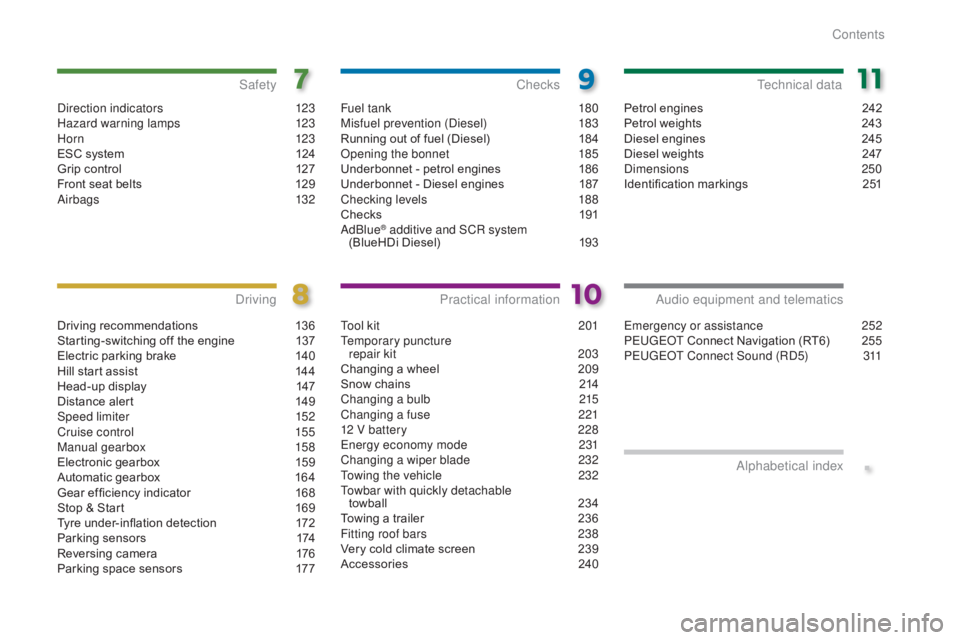
.
3008_en_Chap00a_sommaire_ed01-2015
Direction indicators 123
Hazard warning lamps 1 23
H or n
12
3
ESC system
1
24
Grip control
1
27
Front seat belts
1
29
Airbags
1
32
Safety
Driving recommendations 136
Starting-switching off the engine 1 37
Electric parking brake
1
40
Hill start assist
1
44
Head-up display
1
47
Distance alert
1
49
Speed limiter
1
52
Cruise control
1
55
Manual gearbox
1
58
Electronic gearbox
1
59
Automatic gearbox
1
64
Gear ef ficiency indicator
1
68
Stop & Start
1
69
Tyre under-inflation detection
1
72
Parking sensors
1
74
Reversing camera
1
76
Parking space sensors
1
77
Driving
Emergency or assistance 2 52
PE UGEOT C onnect Navigation (RT6) 2 55
P
E
UGEOT
C
onnect Sound (RD5)
3
11
Audio equipment and telematics
Alphabetical index
Fuel tank 1 80
Misfuel prevention (Diesel) 1 83
Running out of fuel (Diesel)
1
84
Opening the bonnet
1
85
Underbonnet - petrol engines
1
86
Underbonnet - Diesel engines
1
87
Checking levels
1
88
Checks
19
1
AdBlue
® additive and SCR system
(BlueHDi Diesel) 1 93
Checks
Tool kit 2 01
Temporary puncture repair kit
2
03
Changing a wheel
2
09
Snow chains
2
14
Changing a bulb
2
15
Changing a fuse
2
21
12 V battery
2
28
Energy economy mode
23
1
Changing a wiper blade
2
32
Towing the vehicle
2
32
Towbar with quickly detachable
towball
2
34
Towing a trailer
2
36
Fitting roof bars
2
38
Very cold climate screen
2
39
Accessories
2
40
Practical information
Petrol engines 2 42
Petrol weights 2 43
Diesel engines
2
45
Diesel weights
2
47
Dimensions
250
Identification markings
2
51
Technical data
Contents
Page 15 of 344
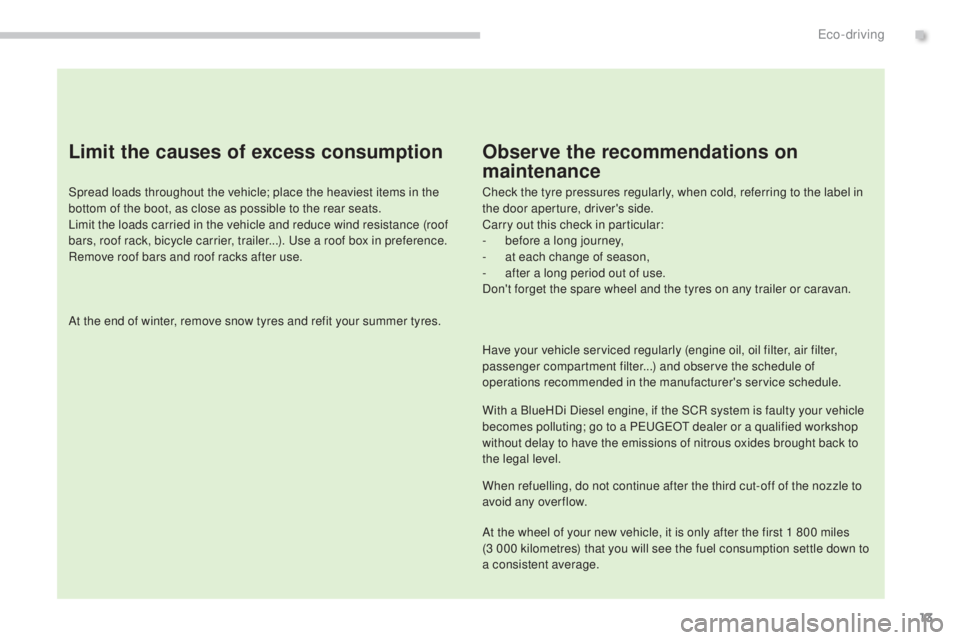
13
3008_en_Chap00c_eco-conduite_ed01-2015
Limit the causes of excess consumption
Spread loads throughout the vehicle; place the heaviest items in the
bottom of the boot, as close as possible to the rear seats.
Limit the loads carried in the vehicle and reduce wind resistance (roof
bars, roof rack, bicycle carrier, trailer...). Use a roof box in preference.
Remove roof bars and roof racks after use.
At the end of winter, remove snow tyres and refit your summer tyres.
Observe the recommendations on
maintenance
Check the tyre pressures regularly, when cold, referring to the label in
the door aperture, driver's side.
Carry out this check in particular:
-
b
efore a long journey,
-
a
t each change of season,
-
a
fter a long period out of use.
Don't forget the spare wheel and the tyres on any trailer or caravan.
Have your vehicle serviced regularly (engine oil, oil filter, air filter,
passenger compartment filter...) and observe the schedule of
operations recommended in the manufacturer's service schedule.
With a BlueHDi Diesel engine, if the SCR system is faulty your vehicle
becomes polluting; go to a PEUGEOT dealer or a qualified workshop
without delay to have the emissions of nitrous oxides brought back to
the legal level.
When refuelling, do not continue after the third cut-off of the nozzle to
avoid any over flow.
At the wheel of your new vehicle, it is only after the first 1 800 miles
(3
000 kilometres) that you will see the fuel consumption settle down to
a consistent average.
.
Eco-driving
Page 144 of 344
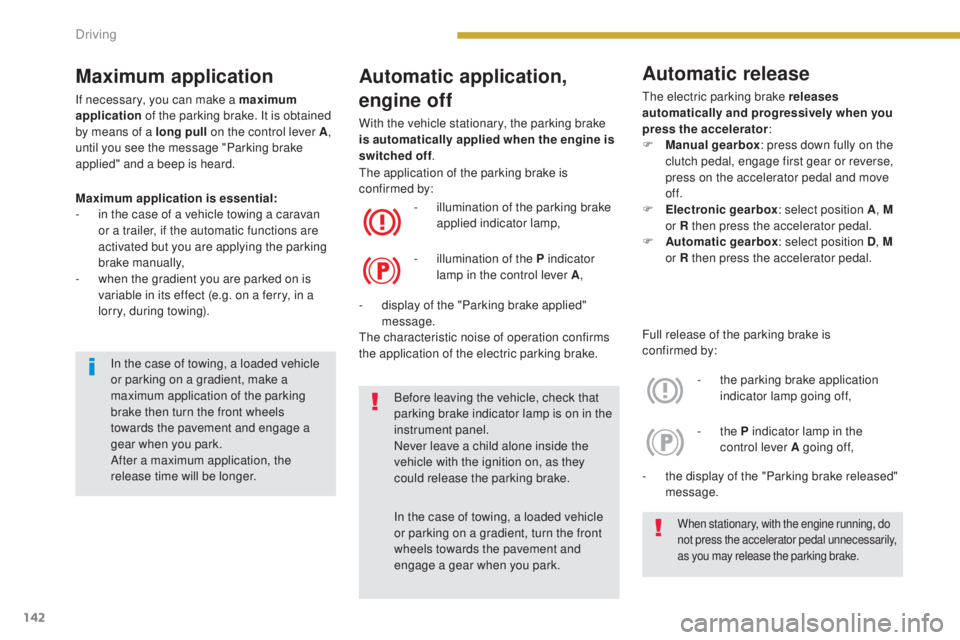
142
3008_en_Chap08_conduite_ed01-2015
Automatic application,
engine off
With the vehicle stationary, the parking brake
is automatically applied when the engine is
switched off.
Maximum application is essential:
-
i
n the case of a vehicle towing a caravan
or a trailer, if the automatic functions are
activated but you are applying the parking
brake manually,
-
w
hen the gradient you are parked on is
variable in its effect (e.g. on a ferry, in a
lorry, during towing). -
i
llumination of the parking brake
applied indicator lamp,
-
d
isplay of the "Parking brake applied"
message.
The characteristic noise of operation confirms
the application of the electric parking brake. The application of the parking brake is
confirmed by:
-
i
llumination of the P indicator
lamp in the control lever A ,
Before leaving the vehicle, check that
parking brake indicator lamp is on in the
instrument panel.
Never leave a child alone inside the
vehicle with the ignition on, as they
could release the parking brake.
In the case of towing, a loaded vehicle
or parking on a gradient, turn the front
wheels towards the pavement and
engage a gear when you park.
When stationary, with the engine running, do
not press the accelerator pedal unnecessarily,
as you may release the parking brake.
In the case of towing, a loaded vehicle
or parking on a gradient, make a
maximum application of the parking
brake then turn the front wheels
towards the pavement and engage a
gear when you park.
After a maximum application, the
release time will be longer.
Maximum application
If necessary, you can make a maximum
application of the parking brake. It is obtained
by means of a long pull on the control lever
A,
until you see the message "Parking brake
applied" and a beep is heard.
Full release of the parking brake is
confirmed
by:
-
t
he parking brake application
indicator lamp going off,
-
t
he display of the "Parking brake released"
message. -
the P indicator lamp in the
control lever A going of f,
Automatic release
The electric parking brake releases
automatically and progressively when you
press the accelerator :
F
M
anual gearbox : press down fully on the
clutch pedal, engage first gear or reverse,
press on the accelerator pedal and move
of f.
F
E
lectronic gearbox : select position A, M
or R then press the accelerator pedal.
F
A
utomatic gearbox : select position D, M
or R then press the accelerator pedal.
Driving
Page 177 of 344
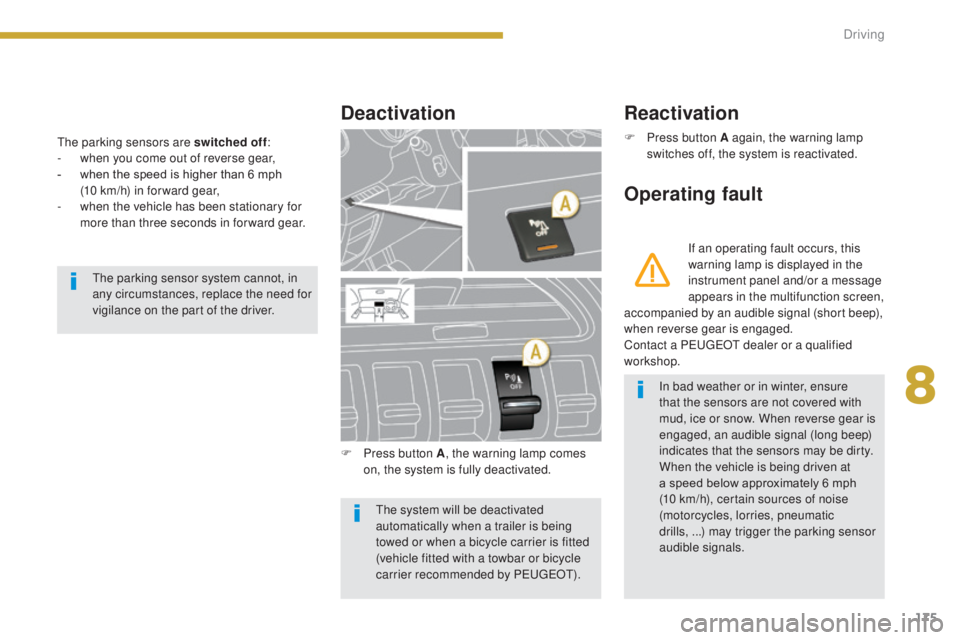
175
3008_en_Chap08_conduite_ed01-2015
The parking sensors are switched off:
- w hen you come out of reverse gear,
-
w
hen the speed is higher than 6 mph
(10 km/h) in for ward gear,
-
w
hen the vehicle has been stationary for
more than three seconds in forward gear.
Deactivation
Operating fault
F Press button A again, the warning lamp switches off, the system is reactivated.
F
P
ress button A , the warning lamp comes
on, the system is fully deactivated. If an operating fault occurs, this
warning lamp is displayed in the
instrument panel and/or a message
appears in the multifunction screen,
accompanied by an audible signal (short beep),
when reverse gear is engaged.
Contact a PEUGEOT dealer or a qualified
workshop.
The parking sensor system cannot, in
any circumstances, replace the need for
vigilance on the part of the driver.
The system will be deactivated
automatically when a trailer is being
towed or when a bicycle carrier is fitted
(vehicle fitted with a towbar or bicycle
carrier recommended by PEUGEOT).In bad weather or in winter, ensure
that the sensors are not covered with
mud, ice or snow. When reverse gear is
engaged, an audible signal (long beep)
indicates that the sensors may be dirty.
When the vehicle is being driven at
a speed below approximately 6 mph
(10 km/h), certain sources of noise
(motorcycles, lorries, pneumatic
drills, ...) may trigger the parking sensor
audible signals.
Reactivation
8
Driving
Page 225 of 344
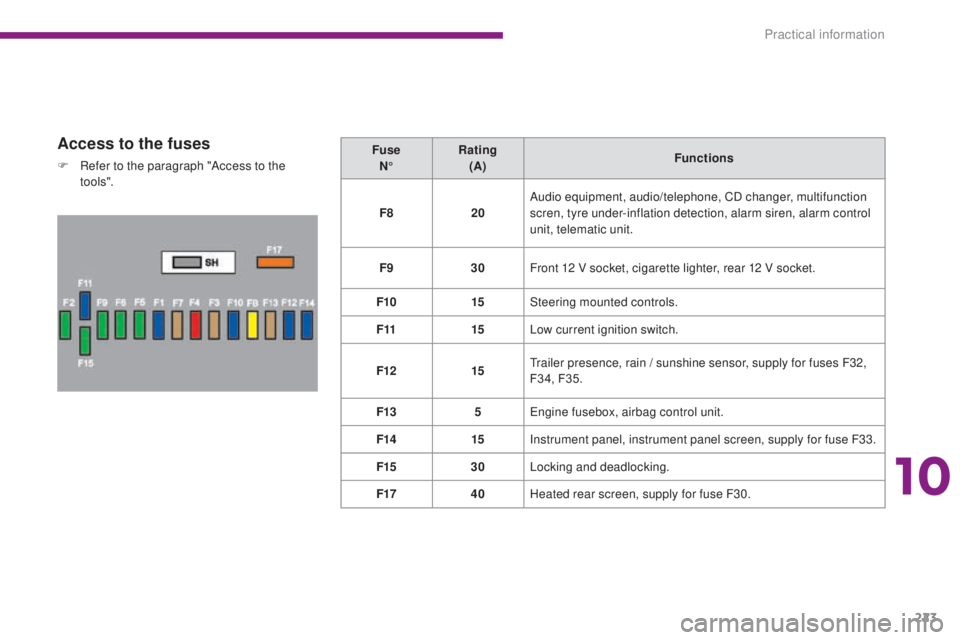
223
3008_en_Chap10_infos-pratiques_ed01-2015
Access to the fuses
F Refer to the paragraph "Access to the to o ls". Fuse
N° Rating
(A) Functions
F8 20Audio equipment, audio/telephone, CD changer, multifunction
scren, tyre under-inflation detection, alarm siren, alarm control
unit, telematic unit.
F9 30Front 12 V socket, cigarette lighter, rear 12 V socket.
F10 15Steering mounted controls.
F11 15Low current ignition switch.
F12 15Trailer presence, rain
/ sunshine sensor, supply for fuses F32,
F34, F35.
F13 5Engine fusebox, airbag control unit.
F14 15Instrument panel, instrument panel screen, supply for fuse F33.
F15 30Locking and deadlocking.
F17 40Heated rear screen, supply for fuse F30.
10
Practical information
Page 226 of 344

224
3008_en_Chap10_infos-pratiques_ed01-2015
Fuse N° Rating
(A) Functions
F30 5Heated door mirrors.
F31 30Boot 12 V socket.
F32 5Electronic gearbox gear lever.
F33 10Head-up display, Bluetooth system, air conditioning.
F34 5Seat belt warning lamp display.
F35 10Parking sensors, Hi-Fi amplifier authorisation.
F36 10Trailer fusebox control unit, driver's door control pad.
F37 20Hi-Fi amplifier.
F38 30Driver's electric seat.
F39 20Panoramic sunroof blind.
Practical information
Page 236 of 344
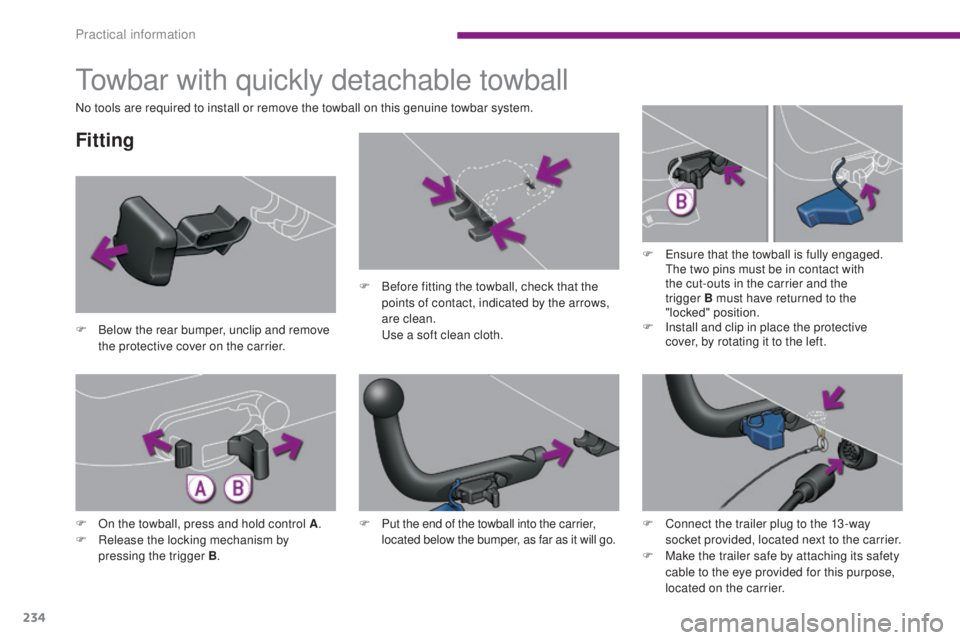
234
3008_en_Chap10_infos-pratiques_ed01-2015
Towbar with quickly detachable towball
Fitting
F Below the rear bumper, unclip and remove the protective cover on the carrier. F
B
efore fitting the towball, check that the
points of contact, indicated by the arrows,
are clean. U se a soft clean cloth.F
E
nsure that the towball is fully engaged.
The two pins must be in contact with
the cut-outs in the carrier and the
trigger
B must have returned to the
"locked" position.
F I nstall and clip in place the protective
cover, by rotating it to the left.
F
O
n the towball, press and hold control A .
F
R
elease the locking mechanism by
pressing the trigger B . F
P
ut the end of the towball into the carrier,
located below the bumper, as far as it will go.
No tools are required to install or remove the towball on this genuine towbar system.
F
C
onnect the trailer plug to the 13 -way
socket provided, located next to the carrier.
F
M
ake the trailer safe by attaching its safety
cable to the eye provided for this purpose,
located on the carrier.
Practical information
Page 237 of 344

235
3008_en_Chap10_infos-pratiques_ed01-2015
When the towball is installed, it may
inter fere with the complete opening of
the lower tailgate.
Take care to avoid the tailgate coming
into contact with the towball.
F
U
nclip and remove the protective cover, by
turning it to the right.
Removing
F Press the trigger B and remove the towball by pulling it towards you.
F
O
n the towball, press and hold control A .
F
R
elease the locking mechanism by
pressing the trigger B . F
C
lip the protective cover in place on the
carrier located below the bumper. If the towball is not locked in place, the
trailer could separate. There is a risk of
an accident.
Always lock the towball in the way
described.
Observe the legislation in force in the
country in which you are driving.
Remove the towball when it is not being
used.
Before setting off, check that the trailer
lighting and signalling works correctly.
Maximum authorised nose weight:
70
kg.
Refer to the "Technical data" section for
the maximum weights and towed loads
for your vehicle.
Carrying system (box or bicycle carrier).
You must not exceed the maximum
nose weight on the towbar: if this weight
is exceeded, the device could detach
from the vehicle and cause a serious
accident.
10
Practical information